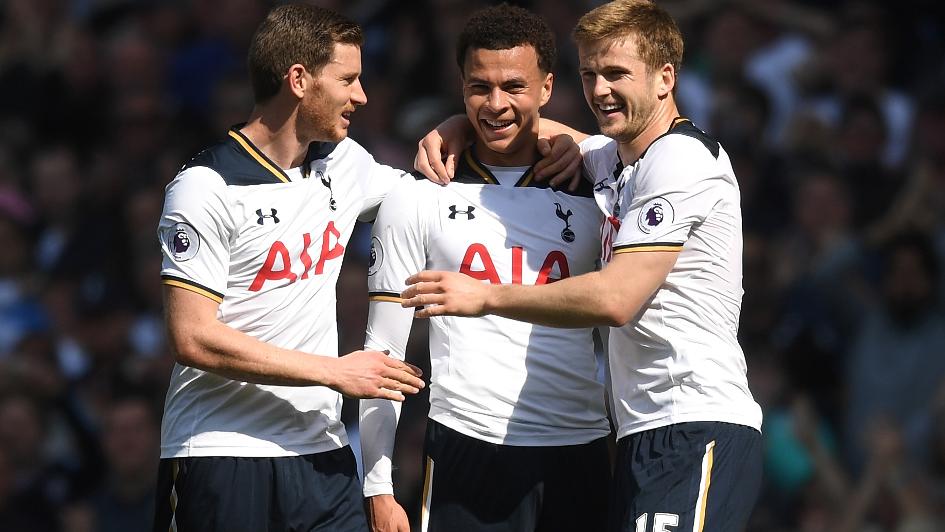Alex Keble looks ahead to Sunday's clash between Tottenham and Arsenal in his latest Five-Star Tactics column.
The north London derby on Sunday afternoon is arguably the most important Premier League meeting between the two sides in a decade.
A 0-0 draw in Manchester on Thursday night has reignited Arsenal’s hopes of a top-four finish this season, while Tottenham remain genuine title contenders; Chelsea could easily drop points at Goodison Park in the earlier kick-off.
Spurs have won all of their last 12 league matches at White Hart Lane and the Gunners have lost four of the last five on the road, but this match is by no means a foregone conclusion.
Rarely are Premier League matches so difficult to predict; neither side’s formation or line-up can be accurately predicted before the team sheet is released on Sunday. Arsenal’s switch to a back three hasn’t really worked despite the upturn in results, and an injury to Laurent Koscielny could force Arsene Wenger to abandon his new system.
Spurs, meanwhile, regularly alternate between 4-2-3-1 and 3-4-2-1 and have some injury concerns of their own.
Here are five key questions ahead of Sunday's game:
1) How will injuries affect Wenger’s choice of formation?
Koscielny will undergo a late fitness test for this one but Shkodran Mustafi has already been ruled out. Without his most important defender, Wenger may decide to switch back to a 4-2-3-1, particularly given Spurs’ tactical strength through the centre of the pitch; familiarity might help the Gunners in their toughest match of the campaign.
However, Wenger rarely – if ever – adapts his system to counter specific threats, and a 3-4-2-1 might actually be more suitable in the absence of their defensive leaders. Gabriel, Rob Holding, and Nacho Monreal all need a lot of help; playing as a trio could relieve pressure on them individually.
There is also a good precedent for matching a 3-4-2-1 (Spurs’ most likely formation) man-for-man; Chelsea have struggled this season against Stoke City, Manchester City, Manchester United and Tottenham when faced with a 3-4-2-1.
The most likely scenario, then, is that the two teams will mirror each other – which should favour Spurs, the stronger and fitter team.
2) Can Xhaka and Coquelin prevent Alli and Eriksen from dominating central attacking midfield?
The biggest tactical failure of the late Wenger years is in central midfield, largely because his formations are too expansive and thus disconnected, with Mesut Ozil rarely tracking back, the defensive line dropping off, and the forwards pressing sporadically, meaning Wenger’s centre-midfielders have to cover an enormous area of the pitch.
Spurs’ narrow attacking lines will surely overwhelm Granit Xhaka and Francis Coquelin, who will patrol alone no matter what formation Arsenal employ.
Dele Alli and Christian Eriksen are arguably the two best attacking midfielders in the country right now. They seek to overwhelm the opposition defensive midfielders by shuttling around the half-spaces in unison, rarely needing to defend thanks to the double defensive pivot of Mousa Dembele and Victor Wanyama.
Both Eriksen and Alli are constantly on the move, shimmying in-between the lines to dominate the number ten space together; against such a wide and under-populated Arsenal midfield, they should be able to run riot at White Hart Lane.
The only way Arsenal can counter this is by stopping delivery at the source. Ozil and Sanchez must work hard to press the Spurs centre-backs and deep-lying midfielders, all of whom are brilliant at cutting low, quick passes through central midfield to their playmakers. If they cannot do this, then one of the Gunners’ back three must step out from the back line to meet Alli and Eriksen.
3) Will Sanchez and Ozil find pockets of space in a Dembele-less midfield?
Dembele’s injury should help Arsenal prevent those penetrating passes through the middle, since the Belgian’s dribbling is such a key element of their narrow attacks. He is also a key player defensively, and in his absence both Ozil and Sanchez may find space on the counter; after all, the main benefit of a 3-4-2-1 is using two inside forwards rather than one number 10.
Against Crystal Palace, Mauricio Pochettino moved Eriksen to a deeper midfield role when Dembele was forced off, but facing such strong attackers he is unlikely to trust the Dane in central midfield. Eric Dier could play in the centre, with Kevin Wimmer replacing him in defence, or Pochettino could move Dier forward and revert to a 4-2-3-1 – as used in Spurs’ last two home games against Bournemouth and Watford.
Whichever he chooses, the result is a significantly less mobile central midfield. Arsenal’s narrow counters, then, could see Sanchez and Ozil get on the ball in surprisingly large amounts of space; this is, by some distance, Arsenal’s best chance of taking something from the game.
4) Can Arsenal penetrate down the right behind Ben Davies?
Dembele’s absence from left-centre midfield also weakens that side of the pitch, where Davies is expected to push forward and stretch the Arsenal backline.
His head-to-head with Hector Bellerin (or Alex Oxlade-Chamberlain) should be a key feature of the game. Chamberlain deserves to play after impressing at right wing-back against Middlesbrough and Man City (10 dribbles in total), but Bellerin’s impressive return against Leicester City in midweek (three key passes, three dribbles) makes it unlikely. However, if Alexis Sanchez starts up-front then Chamberlain may partner Bellerin on the right; this would surely cause Davies all sorts of problems.
Wenger’s new formation has looked disjointed and unconvincing. Arsenal only successfully attacked against Man City and Middlesbrough via Chamberlain’s mazy dribbles down the right, which cut through the opposition ranks and created danger. Up against the marauding Davies and without Dembele to help out, a Bellerin/Chamberlain partnership could prove fruitful.
5) Can Pochettino expose the brittleness of Arsenal’s defensive shape on the outside of the centre-backs?
Manchester City have looked strangely bereft of ideas lately, while both Leicester and Middlesbrough are extremely defensive teams; Arsenal’s new system hasn’t really been tested yet, although close inspection of their last three matches reveals where one should strike.
The biggest chink in Arsenal’s armour is on the outside of the three centre-backs. With the wing-backs pouring forward, an obvious hole opens up that neither Coquelin nor Xhaka are able to plug (because they have too much work to do elsewhere: see above). Pochettino, who spends days pouring over the data to decipher an opponent’s weaknesses, will have noticed this.
Expect Alli, Eriksen, and Harry Kane to spend more time than usual bunched together on their right flank, finding space behind Kieran Gibbs – who is prone to lapses in concentration. We may also see Son Heung-Min given a starring role (or an important cameo from the bench) to further target the right-wing half-space.









